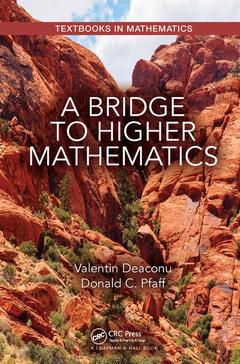Description
A Bridge to Higher Mathematics
Textbooks in Mathematics Series
Authors: Deaconu Valentin, Pfaff Donald C.
Language: English
Subject for A Bridge to Higher Mathematics:
Keywords
Rational Number; Positive Integer; Transition to advanced mathematics; Archimedean Property; Logic; Decimal Representation; Sets; Natural Numbers; Combinatorics; Usual Order Relation; Cardinality; Equivalence Relation; De Morgan’s Laws; Gcd; Upper Bounds; Upper Bound; Nonempty Sets; Cauchy Sequence; Triangle ADB; Nonzero Integers; Hausdorff Maximal Principle; Truth Table; Greatest Common Divisor; Positive Cut; Peano Axioms; Zorn’s Lemma; Common Multiple; Set Builder Notation; Digit A0; Quotient Set
271.33 €
In Print (Delivery period: 14 days).
Add to cartPublication date: 07-2017
· 15.6x23.4 cm · Hardback
93.24 €
In Print (Delivery period: 15 days).
Add to cartPublication date: 02-2017
· 15.6x23.4 cm · Paperback
Description
/li>Contents
/li>Biography
/li>
A Bridge to Higher Mathematics is more than simply another book to aid the transition to advanced mathematics. The authors intend to assist students in developing a deeper understanding of mathematics and mathematical thought.
The only way to understand mathematics is by doing mathematics. The reader will learn the language of axioms and theorems and will write convincing and cogent proofs using quantifiers. Students will solve many puzzles and encounter some mysteries and challenging problems.
The emphasis is on proof. To progress towards mathematical maturity, it is necessary to be trained in two aspects: the ability to read and understand a proof and the ability to write a proof.
The journey begins with elements of logic and techniques of proof, then with elementary set theory, relations and functions. Peano axioms for positive integers and for natural numbers follow, in particular mathematical and other forms of induction. Next is the construction of integers including some elementary number theory. The notions of finite and infinite sets, cardinality of counting techniques and combinatorics illustrate more techniques of proof.
For more advanced readers, the text concludes with sets of rational numbers, the set of reals and the set of complex numbers. Topics, like Zorn?s lemma and the axiom of choice are included. More challenging problems are marked with a star.
All these materials are optional, depending on the instructor and the goals of the course.
Elements of logic
True and false statements
Logical connectives and truth tables
Logical equivalence
Quantifiers
Proofs: Structures and strategies
Axioms, theorems and proofs
Direct proof
Contrapositive proof
Proof by equivalent statements
Proof by cases
Existence proofs
Proof by counterexample
Proof by mathematical induction
Elementary Theory of Sets. Functions
Axioms for set theory
Inclusion of sets
Union and intersection of sets
Complement, difference and symmetric difference of sets
Ordered pairs and the Cartersian product
Functions
Definition and examples of functions
Direct image, inverse image
Restriction and extension of a function
One-to-one and onto functions
Composition and inverse functions
*Family of sets and the axiom of choice
Relations
General relations and operations with relations
Equivalence relations and equivalence classes
Order relations
*More on ordered sets and Zorn's lemma
Axiomatic theory of positive integers
Peano axioms and addition
The natural order relation and subtraction
Multiplication and divisibility
Natural numbers
Other forms of induction
Elementary number theory
Aboslute value and divisibility of integers
Greatest common divisor and least common multiple
Integers in base 10 and divisibility tests
Cardinality. Finite sets, infinite sets
Equipotent sets
Finite and infinite sets
Countable and uncountable sets
Counting techniques and combinatorics
Counting principles
Pigeonhole principle and parity
Permutations and combinations
Recursive sequences and recurrence relations
The construction of integers and rationals
Definition of integers and operations
Order relation on integers
Definition of rationals, operations and order
Decimal representation of rational numbers
The construction of real and complex numbers
The Dedekind cuts approach
The Cauchy sequences approach
Decimal representation of real numbers
Algebraic and transcendental numbers
Comples numbers
The trigonometric form of a complex number
These books may interest you

Introduction to Mathematical Proofs 117.69 €



